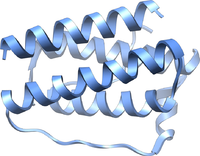
Photo from wikipedia
Objective Hypothalamic inflammation and endoplasmic reticulum (ER) stress are extensively linked to leptin resistance and overnutrition-related diseases. Surgical intervention remains the most efficient long-term weight-loss strategy for morbid obesity, but… Click to show full abstract
Objective Hypothalamic inflammation and endoplasmic reticulum (ER) stress are extensively linked to leptin resistance and overnutrition-related diseases. Surgical intervention remains the most efficient long-term weight-loss strategy for morbid obesity, but mechanisms underlying sustained feeding suppression remain largely elusive. This study investigated whether Roux-en-Y gastric bypass (RYGB) interacts with obesity-associated hypothalamic inflammation to restore central leptin signaling as a mechanistic account for post-operative appetite suppression. Methods RYGB or sham surgery was performed in high-fat diet-induced obese Wistar rats. Sham-operated rats were fed ad libitum or by weight matching to RYGB via calorie restriction (CR) before hypothalamic leptin signaling, microglia reactivity, and the inflammatory pathways were examined to be under the control of gut microbiota-derived circulating signaling. Results RYGB, other than CR-induced adiposity reduction, ameliorates hypothalamic gliosis, inflammatory signaling, and ER stress, which are linked to enhanced hypothalamic leptin signaling and responsiveness. Mechanistically, we demonstrate that RYGB interferes with hypothalamic ER stress and toll-like receptor 4 (TLR4) signaling to restore the anorexigenic action of leptin, which most likely results from modulation of a circulating factor derived from the altered gut microbial environment upon RYGB surgery. Conclusions Our data demonstrate that RYGB interferes with hypothalamic TLR4 signaling to restore the anorexigenic action of leptin, which most likely results from modulation of a circulating factor derived from the post-surgical altered gut microbial environment.
Journal Title: Molecular Metabolism
Year Published: 2021
Link to full text (if available)
Share on Social Media: Sign Up to like & get
recommendations!